WHEAT DISEASE- SYMPTOMS & CONTROL
In this blog, all important disease of wheat is covered with their occurrence, symptoms of disease and control measures.
Leaf Rust /Brown Rust: Puccinia triticina
Symptoms
- Circular or slightly elliptical pustules, smaller than those of stem rust, usually do not coalesce, and contain masses of orange to orange-brown Urediospores.
- Primary infection sites are upper surfaces of leaves and leaf sheaths.
- Uredospores spread from hills and survive on stubbles and volunteer crops.
- Alternate host: Thalictrumsp.
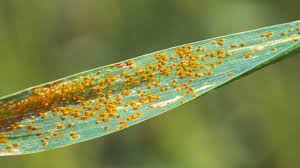
Management
- Mixed cropping with suitable crops.
- Avoid excess dose of nitrogenous fertilizers.
- Spray Zineb at 2.5 kg/ha or Propioconazole @ 0.1 %.
- Grow resistant varieties like PBW 343, PBW 550, and PBW 17.
Stem Rust or Black Rust- Puccinia graminis tritici
Symptoms
- Dark reddish brown Pustules (containing masses of urediospores) occur on both sides of the leaves, stems, and on the spikes.
- Pustules are usually separate and scattered, heavy infections –coalesce.
- “Flecks” may appear before pustule formation. Before the spore masses break through the epidermis, the infection sites feel rough to the touch.
- As the spore masses break through, the surface tissues take on a ragged and torn appearance
- Spread by urediospores from hills; survive on stubbles and volunteer crops both.
- Alternate host: Berberis spp.
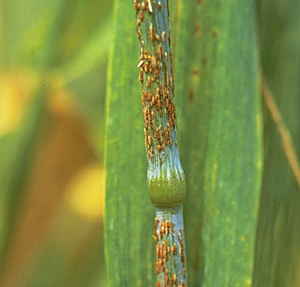
Management
- Avoid excess nitrogen.
- Mixed cropping and crop rotation.
- Sulphur dusting @ 35-40 kg/ha
- Mancozeb @ 2g/lit
- Grow resistant varieties like Lerma Rojo, Safed Lerma, Sonalika and Chotil.
Stripe Rust/Yellow Rust- Puccinia striiformis
Symptom
- Pustules contain yellow to orange-yellow uredospores, form narrow stripes on the leaves. Pustules also can be found on leaf sheaths, necks, and glumes.
- Survival: Both survive on stubbles and volunteer crops.
- Spread: uredospores from hill.
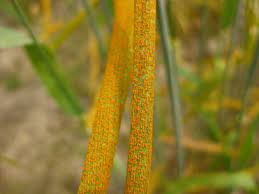
Management
- Mixed cropping and crop rotation.
- Avoid excess Nitrogen.
- Sulphur dusting @ 35-40 kg/ha
- Mancozeb @ 2g/lit
- Resistant varieties– same as in stem rust.
Loose Smut- Ustilago tritici
Symptom
- The entire inflorescence, except the rachis, is filled by masses of smut spores (teliospores).
- These black teliospores often are blown away by the wind, leaving only the bare rachis and remnants of other floral structures.
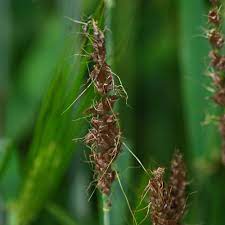
Management
- Seed treatment with Vitavax @ 2g/kg seed.
- Burry the infected ear heads in the soil.
Powdery mildew- Erysiphe graminis var. tritici
Symptom
- Greyish white powdery growth appears on the leaf, sheath, stem and floral parts.
- Powdery growth later become black lesion and cause drying of leaves and other parts.
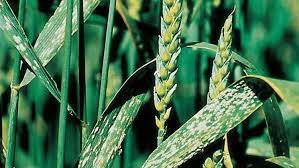
Management
- Spray Wettable sulphur 2% or Carbendazim @ 500 g/ha.
Flag smut- Urocystis agropyri
Occurrence
- Seed and soil borne, primary infection occurs by sowing infected seeds or by resting spores present in the soil.
- Favourable conditions are temperature of 18-24°C, Relative humidity 65% and above.
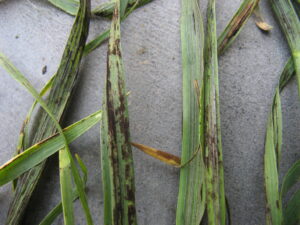
Symptoms
- Symptoms can be seen on stem, clum and leaves from late seedling stage to maturity.
- The seedling infection leads to twisting and drooping of leaves followed by withering.
- Grey to grayish black sori occurs on leaf blade and sheath. The sorus contains black powdery mass of spores.
Hill bunt or Stinking smut or common bunt- Tilletia tritici
Occurrence
- Seeds are source of primary infection as pathogen survives in seeds.
- 18-20°C temperature and high soil moisture are favorable conditions for spread of the disease.
Symptoms
- The fungus attacks on 8-10 days old seedling become systemic and grow along the tip of shoot.
- Hyphae concentrate in the inflorescence and spikelets during flowering and transform the ovary into smut spores (chlamydospores) of dark green color.
- The diseased plants mature early and all the spikelets are affected.
Karnal bunt or Partial bunt- Tilletia indica
Occurrence
- Karnal bunt was first discovered by Mitra (1930) in Karnal, India.
- Seed is the source of primary infection.
- Favorable conditions are 18-20°C temperature and high soil moisture.
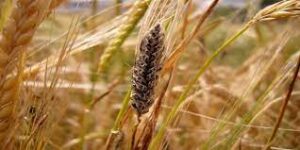
Symptoms
- Extremely difficult to diagnose in the field. First, not all kernels on a plant head will be infected, and thus infected plants are not as readily identifiable. Due to such distribution, Karnal bunt is also known as partial bunt. Second, that most infected kernels do not show symptoms prior to maturity.
- The disease produces dark color and a fishy smell on infected kernels. The darkening of the kernel is a result of the kernel tissue being converted in a teliospore mass by the fungus.
- In the process of replacing the healthy kernel with teliospores, the disease tends to hollow out host kernels, resulting in a canoe shape.
Frequently Asked Question (FAQ)
Blight and Rust resistant variety of wheat are?
UP2425, PBW 273, WH 291.
Which variety of wheat is resistant against all three Rust?
Choti lerma.
Most damaging rust disease of wheat is?
Brown Rust/leaf Rust
Killer disease of wheat is?
Stem Rust/Black Rust
Cancer disease of wheat is?
Karnal bunt.
Ear cockle of wheat is cause by?
Anguina tritici.
Soil, seed and Air-borne disease of wheat is?
Karnal bunt.
The characteristic “fishy smell” in karnal bunt disease is due to?
Trimethyl amine.
Read also…
RICE DISEASE- SYMPTOMS & MANAGEMENT